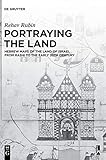Portraying the Land : Hebrew Maps of the Land of Israel from Rashi to the Early 20th Century / Rehav Rubin.
Material type: TextPublisher: Berlin ; Boston : De Gruyter, [2018]Description: 1 online resource (XXV, 326 p.)Content type:
TextPublisher: Berlin ; Boston : De Gruyter, [2018]Description: 1 online resource (XXV, 326 p.)Content type: - 9783110564532
- 9783110568936
- 9783110570656
- GA1321 .R8313 2019
- GA1321 .R8313 2019
- online - DeGruyter
- Issued also in print.
| Item type | Current library | Call number | URL | Status | Notes | Barcode | |
|---|---|---|---|---|---|---|---|
 eBook
eBook
|
Biblioteca "Angelicum" Pont. Univ. S.Tommaso d'Aquino Nuvola online | online - DeGruyter (Browse shelf(Opens below)) | Online access | Not for loan (Accesso limitato) | Accesso per gli utenti autorizzati / Access for authorized users | (dgr)9783110570656 |
Browsing Biblioteca "Angelicum" Pont. Univ. S.Tommaso d'Aquino shelves, Shelving location: Nuvola online Close shelf browser (Hides shelf browser)
Frontmatter -- Contents -- Preface -- List of the Maps Presented in the Book -- Introduction -- 1. Rashi and His Maps -- 2. Following in Rashi’s Footsteps -- 3. Between Jewish and Christian Maps: The Sixteenth-Century Map of the Israelites’ Peregrinations from Mantua -- 4. Following in the Footsteps of Christian Cartographers -- 5. The Debut of the Tribal Allotments on the Traditional Hebrew Map -- 6. Cartographic Tableaux of the Holy Places -- 7. From Tradition to Modernity—the Hebrew Map between the Nineteenth Century and Early Twentieth Century -- Conclusion -- Cartographic Material -- Bibliography -- Index
restricted access online access with authorization star
http://purl.org/coar/access_right/c_16ec
The book presents and discusses a large corpus of Jewish maps of the Holy Land that were drawn by Jewish scholars from the 11th to the 20th century, and thus fills a significant lacuna both in the history of cartography and in Jewish studies. The maps depict the biblical borders of the Holy Land, the allotments of the tribes, and the forty years of wanderings in the desert. Most of these maps are in Hebrew although there are several in Yiddish, Ladino and in European languages. The book focuses on four aspects: it presents an up-to-date corpus of known maps of various types and genres; it suggests a classification of these maps according to their source, shape and content; it presents and analyses the main topics that were depicted in the maps; and it puts the maps in their historical and cultural contexts, both within the Jewish world and the sphere of European cartography of their time. The book is an innovative contribution to the fields of history of cartography and Jewish studies. It is written for both professional readers and the general public. The Hebrew edition (2014), won the Izhak Ben-Zvi Prize.
Issued also in print.
Mode of access: Internet via World Wide Web.
In English.
Description based on online resource; title from PDF title page (publisher's Web site, viewed 04. Okt 2022)









